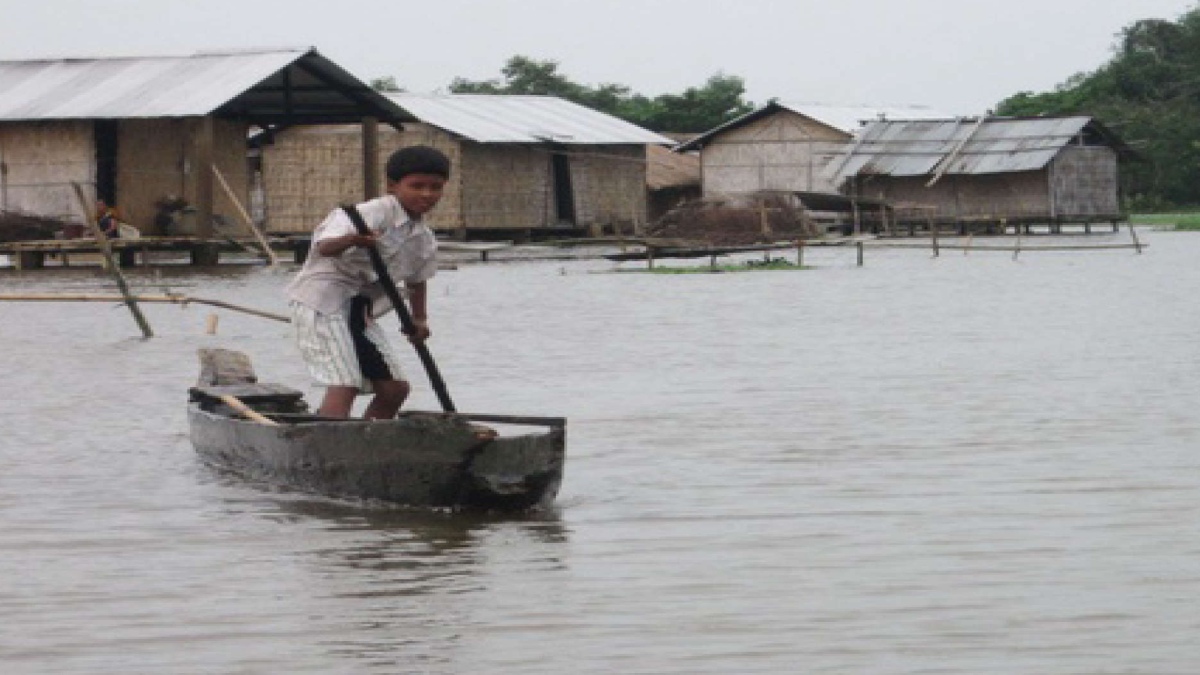India suffered an average annual loss of around USD 87 billion in 2020 due to extreme weather events, such as tropical cyclones, floods and droughts as per the State of the Climate (SoC) in Asia 2020 report by the World Meteorological Organization (WMO). The report, released last week, highlights the impact of extreme weather and climate change which, in the past year, has caused the loss of life of thousands of people, displaced millions and cost the country hundreds of dollars because of the impact it has had on infrastructure and ecosystems.
In 2020, countries across Asia faced the extremely difficult task of managing the devastating impact of the first wave of the COVID-19 pandemic while mitigating the disaster relief efforts due to such extreme weather events. This was particularly challenging for both India and Bangladesh, which suffered the onslaught of Cyclone Amphan in May 2020, wherein millions of people were displaced and billions of dollars in lost in property and infrastructure. Extreme weather events and climate change act as threat multipliers to poverty, and the SoC highlights the disproportionate impact such events have on already vulnerable populations and climate-sensitive industries, including agriculture, water resources, health and energy.
WHAT DOES THE SoC STATE?
The State of the Climate (SoC) in Asia 2020 is a multi-agency report aimed at providing
science-based knowledge on the state of the climate in Asia and its inter-connection with sustainable development in the region. The report highlights how extreme weather and climate hazards, especially floods, storms, and droughts have a significant impact on many countries in Asia, particularly, India, China and Japan, and affect agriculture and food security. This, in turn, contributes to the increased vulnerability of migrants and those displaced by such extreme weather events. It also increases health risks and leads to a major loss in natural ecosystems. The report highlights that the COVID-19 pandemic further complicated disaster management efforts for countries as they faced the dual challenge of tackling the pandemic as well as climate change-related hazards with limited resources and time. Extreme weather events covered in the purview of the report include floods, storms, excessive rain, sandstorms, heatwaves and cyclones.



The report mentions that in 2020, floods and storms affected around 50 million people, including around 5,000 lives lost. In absolute terms, India and China suffered the most from such extreme events: USD 26.3 billion and USD 23.1 billion, respectively. This impact translated into the percentage of gross domestic product (GDP), which in India exceeds 0.5% of GDP. Climate and weather events had a disproportionate impact on those displaced in the population. Most of the disaster-related displacement recorded globally in 2020 took place in China, Bangladesh and India, which recorded some of the highest figures globally of about 4-5 million new displacements each.
The report also speaks of the impact such events have on food security and nutrition, where improvements have already slowed down in Asia and are not on track to achieve the Sustainable Development Goal targets of ending hunger and all forms of malnutrition by 2030 (targets 2.1 and 2.2). It is estimated that in 2020, 48.8 million people in South-East Asia, 305.7 million in South Asia and 42.3 million in West Asia were undernourished. There was larger scale undernourishment recorded in countries affected by other drivers particularly climate-related disasters. Extreme climate events can wipe out thousands of hectares of produce and agricultural land, impact the supply chain of essential commodities, functioning of local markets, limit the availability of or access to firewood and safe water and directly impact the prices of food.
Additionally, climate change and related extreme events have direct negative environmental effects including causing damage to healthy ecosystems. These include pollutants and hazardous chemicals from flooded industrial sites entering groundwater, rivers and oceans; and wildfires, floods and storms defoliating forests and disrupting ecosystems.
Source: Creative Commons
IMPACT OF CYCLONE AMPHAN
The impact of Cyclone Amphan which hit the very densely populated coastal areas in Bangladesh and India during the rapid spread of COVID-19 in May 2020 is detailed in this report. In West Bengal, 86 people lost their lives and 13.6 million people were affected. The damage to infrastructure and property amounted to approximately USD 14 billion. Bangladesh reported total damage of more than USD 130 million. A total of 10 million people in 19 districts were affected, and more than 330,000 houses were damaged due to the cyclone. The cyclone hit the countries when the first wave of COVID-19 was surging across the world, and both governments faced the incredibly difficult task of mitigating disaster relief efforts owing to major restrictions imposed during the pandemic and the disruption of supply chains
The cyclone displaced around 2.4 million people in India, mostly in West Bengal and Odisha, and 2.5 million people in Bangladesh. Around 2.8 million homes have been damaged, leading to widespread homelessness and prolonged displacement. As many did not have access to evacuation centres they were compelled to take shelter in tents or in the open on embankments. The damage associated with Cyclone Amphan affected all forms of infrastructure and agriculture. This includes social infrastructure such as housing, schools and hospitals; physical infrastructure including access to energy, transport, water and sanitation; and communication networks and agriculture, including damage of crops and livestock.
ECONOMIC IMPACT OF EXTREME WEATHER EVENTS
The specific damage and losses caused by extreme weather events vary from event to event due to the characteristics of the affected region. However, all such events have large impacts on major sectors of the economy and have a major implication on socioeconomic indicators, such as transportation cost, employment, food security and trade. The SoC mentions that in the past few years, the economic costs of extreme events have been rising due to the high proportion of critical infrastructures being located in multi-hazard risk hotspots. This leads to a major disruption in economic activity when natural disasters occur. Climate change often acts as a threat multiplier to poverty, through cascading effects and compounding risks that need to be addressed in disaster risk reduction efforts.


India is exposed to increasingly frequent floods, droughts and cyclones and as per the National Disaster Management Authority (NDMA), 12% of India’s total land area is exposed to flooding and 68% of cultivable land is exposed to drought. 80% of the total coastline is exposed to cyclones and tsunamis. The country is also witnessing associated events corresponding to that of the heatwaves, cold waves, extreme rainfall, landslides and avalanches as a new normal due to changes in the microclimate and surface temperature. With only about 9% of the world’s arable land, agriculture in India feeds about 17.2% of the global population and over 56% of the country’s total agricultural area is rainfed. This means that India’s food security and agricultural livelihoods depend heavily on the monsoon, making it extremely vulnerable to climate change. The impact of such events is even higher in some states which have a history of frequent extreme weather disasters. This includes states such as Jharkhand, Odisha and Chhattisgarh which are prone to severe droughts as well as the states of Bihar and Assam, which are faced with floods almost every year. Andhra Pradesh and West Bengal experience regular cyclones. On average it is estimated that USD 2.3 billion was paid for crop losses by insurance companies. Additionally, increased heat and humidity can lead to an effective loss of outdoor working hours, putting between USD 2.8 trillion and USD 4.7 trillion of GDP in Asia annually at risk by 2050, on average. In 2020, a larger number of Indian cities reported temperatures of 48°C or more.
WHAT CAN BE DONE?

According to Germanwatch’s 2020 findings, India is the seventh-most vulnerable country with respect to climate extremes. The SoC calls for the need to build climate-resilient economies and societies which have become more necessary than ever to “build back better” from the COVID-19 pandemic. This can be done by enhanced monitoring of climate drivers at regional scales and increased funding for climate observing and early warning systems, and associated services. It also involves an improved understanding of risks of climate change, as well as investment in frontier technologies, health and social protection of those most vulnerable to extreme weather events.

The improvement of all adaptation measures, including the implementation of early warning systems (EWS) has been highlighted as the key component to reducing Asia’s exposure and vulnerability to extreme weather events. Additionally, there are still major gaps in the availability of climate observations in the region, particularly in South and Southwest Asia. There is an increasing need to promote climate change-related outcomes in climate-sensitive sectors such as agriculture, water resources, health and energy. This has been highlighted in the United Nations Framework Convention on Climate Change as the top priority for decision-makers and policymakers around the globe.
Source: Creative Commons
Contributing reports by Damini Mehta, Junior Research Associate at Polstrat and Abhilasha Rawat and Devak Singh, Interns at Polstrat.























